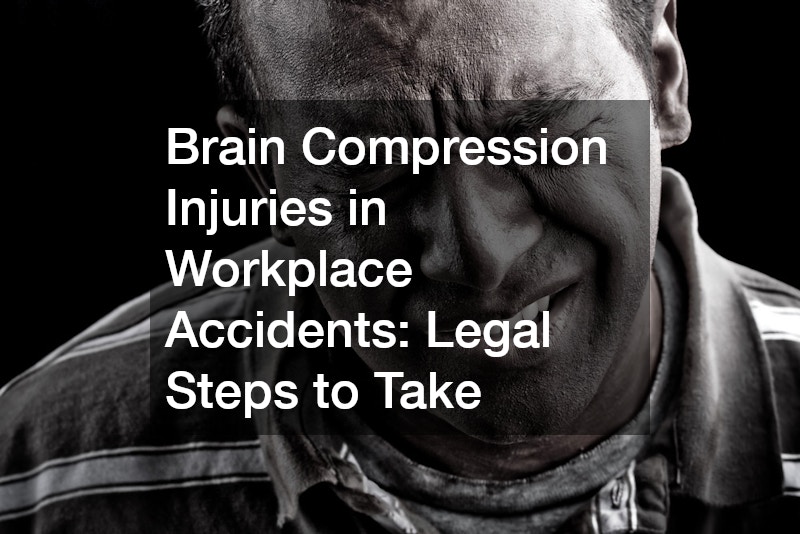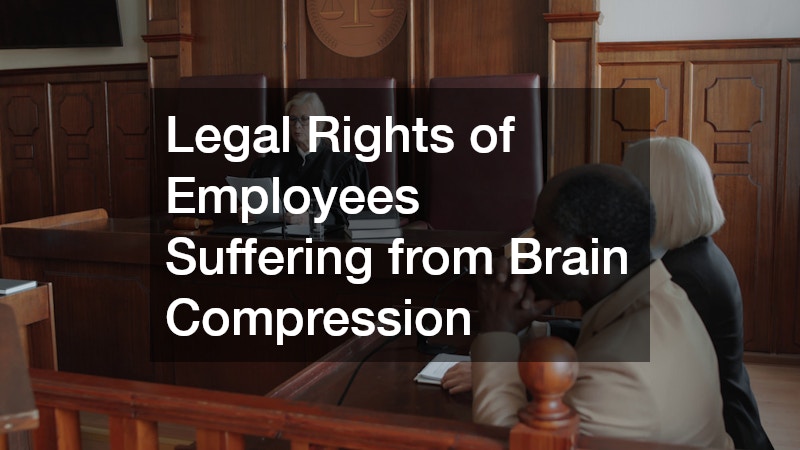
Brain compression injuries represent one of the most severe and life-altering types of trauma that can occur in the workplace. These injuries arise when pressure builds within the skull, compressing brain tissue and disrupting normal function. Workplace accidents—from falling equipment to motor vehicle crashes—can cause this kind of damage in an instant, leaving employees with long-term physical, cognitive, and emotional challenges. Understanding what to do after such an injury is vital not only for recovery but also for protecting one’s legal rights.
Victims of brain compression injuries often face steep medical bills, prolonged rehabilitation, and the possibility of permanent disability. Navigating the aftermath requires more than medical care; it demands knowledge of the legal steps needed to ensure fair compensation and accountability. Whether you are an injured employee, a family member, or an employer seeking to understand responsibilities, recognising the legal implications of brain compression injuries is essential. Consulting a qualified personal injury attorney early can make the difference between financial stability and ongoing hardship. This article explores what these injuries entail, how they occur, and the crucial legal steps victims should take to safeguard their rights and secure the support they need after a workplace accident.
What Are Brain Compression Injuries?
A brain compression injury occurs when internal bleeding, swelling, or bone fragments increase pressure inside the skull, compressing brain tissue and disrupting oxygen flow. Such compression can result from blunt-force trauma, falls, or machinery-related accidents common in industrial or construction environments. The causes vary, but the outcome is often severe, leading to symptoms like headaches, dizziness, loss of coordination, or even coma.
Diagnosis typically involves advanced imaging techniques such as CT or MRI scans, helping doctors determine the extent of swelling or hemorrhage. Immediate medical attention is crucial to prevent permanent brain damage or death. Short-term consequences may include confusion, nausea, or memory lapses, while long-term effects can manifest as chronic pain, cognitive decline, or paralysis. Proper pain care is vital throughout the recovery process, ensuring comfort and supporting rehabilitation.
Statistics reveal that traumatic brain injuries (TBIs) contribute to a significant portion of workplace fatalities and disabilities each year. In high-impact environments, such as construction, logistics, or manufacturing, the prevalence of compression-type injuries underscores the importance of safety awareness. Understanding these medical realities helps victims communicate effectively with healthcare providers, employers, and legal representatives, ensuring their rights are upheld throughout every stage of recovery and litigation.
How Do Brain Compression Injuries Occur in the Workplace?
Workplace brain compression injuries often stem from preventable incidents involving heavy machinery, falling debris, or vehicular collisions. Employees working near elevated platforms, cranes, or transport vehicles are at higher risk of suffering blunt-force trauma to the head. In some cases, poor maintenance or missing warning decals on hazardous equipment can lead to devastating outcomes. High-risk industries like construction, oil and gas, and manufacturing report the majority of workplace brain injuries due to the combination of heavy tools, high elevations, and confined spaces.
Safety equipment such as helmets, harnesses, and impact-resistant gear can drastically reduce the risk of compression injuries. However, these measures are only effective when employers provide them and ensure workers use them properly. Failure to maintain safety protocols or provide adequate training may constitute negligence, making the employer legally responsible for resulting harm.
In certain tragic incidents, emergency sirens sound across the job site as responders rush to provide aid to injured workers. These moments underscore the critical importance of prevention and preparedness. Understanding how and why these injuries occur is key for both employees and employers. It sets the foundation for identifying liability, enforcing workplace safety laws, and ensuring accountability through legal action when negligence plays a role.
Signs You May Have a Claim for Workplace Brain Compression Injuries
Not every workplace injury automatically results in a valid legal claim, but many do when negligence or unsafe conditions contribute to the incident. Understanding liability is the first step. Employers have a duty to provide a safe environment, maintain equipment, and follow safety regulations. If these duties are breached, the injured worker may have grounds to file a claim with the help of a personal injury attorney.
Evaluating workplace conditions is essential—look for signs such as faulty machinery, poor signage, or inadequate supervision. Documenting these issues strengthens your case. Identifying employer responsibilities also includes verifying that safety procedures were in place and properly communicated to all staff. Determining negligence may involve collecting witness statements, inspection reports, or maintenance logs.
Gathering evidence early is critical. Photos of the accident scene, medical reports, and correspondence with management all contribute to proving fault. Victims often benefit from guidance by an experienced bondsman or legal support network familiar with workplace injury litigation, particularly when multiple parties are involved. Recognising these warning signs early allows injured employees to take decisive action—transforming uncertainty into a well-supported claim for justice and fair compensation.
Legal Rights of Employees Suffering from Brain Compression
Workers suffering from brain compression injuries possess specific legal rights under workers’ compensation laws and civil injury statutes. Most employees are eligible for workers’ compensation benefits, which cover medical expenses and partial wage replacement. However, these benefits may not fully address the extent of damages, especially if negligence or defective equipment contributed to the injury. In such cases, victims can pursue additional compensation through a civil lawsuit.
An experienced criminal defense lawyer or injury law specialist can help determine whether multiple parties, such as contractors, equipment manufacturers, or employers, share responsibility. Understanding settlements is another key aspect—victims may receive compensation for lost wages, pain and suffering, ongoing medical care, and rehabilitation. The right to medical treatment is protected under law, meaning employers cannot deny or delay necessary care.
In cases involving complex liability, coordination between a bail bond agency and legal representatives may occasionally arise, particularly if regulatory violations or criminal negligence are under investigation. Ultimately, awareness of one’s legal rights ensures victims receive not only medical recovery but also financial justice. Knowledge empowers injured workers to hold negligent parties accountable and reclaim stability after a life-altering accident.
Steps to Take Immediately After Sustaining a Brain Compression Injury
Immediate action following a workplace injury can drastically influence both medical recovery and legal outcomes. The first and most important step is seeking urgent medical care. Brain compression injuries require rapid evaluation and treatment to prevent further damage. Once stabilized, the incident must be promptly reported to your employer—this formal record will be essential in future claims.
Documenting the event is the next priority. Photographs of the accident site, witness statements, and copies of incident reports create a factual foundation for your case. Contacting legal counsel early ensures that deadlines and procedures are met correctly, especially when navigating the complexities of workers’ compensation or personal injury claims.
Preserving evidence is crucial. Keep medical receipts, correspondence, and diagnostic images. If your employer discourages reporting or attempts to minimize the situation, consult a dui attorney or workplace law specialist—many of these professionals also handle serious injury claims where negligence overlaps with criminal liability. These proactive measures help secure your rights and pave the way for fair compensation. Acting quickly after a brain compression injury isn’t just about recovery—it’s about protecting your future and holding negligent parties accountable.
Choosing the Right Attorney for Your Case
Selecting the right lawyer can define the success of your claim. It’s essential to find someone who specializes in workplace injuries and has experience handling complex neurological or brain compression cases. A skilled personal injury attorney will understand the medical nuances, legal precedents, and insurance tactics that shape these cases.
During your initial consultation, evaluate the attorney’s background and track record. Firms that offer transparent fee structures—such as contingency-based agreements—allow clients to pursue justice without financial stress. Reviewing testimonials and prior case results helps gauge success rates and client satisfaction.
Specialized attorneys also maintain connections with expert witnesses, investigators, and medical professionals who can substantiate your claims. They will work closely with you to develop a compelling argument for compensation covering lost wages, medical expenses, and long-term care. Choosing representation that prioritizes communication and compassion makes the process less daunting. Whether through negotiation or litigation, the right legal partner ensures you’re never navigating this challenging process alone, helping transform legal confusion into a clear path toward resolution and recovery.
What to Expect During the Legal Process
Once you’ve chosen your lawyer, understanding the legal process helps manage expectations. The journey typically begins with an initial consultation and case assessment, where all details of the injury and circumstances are reviewed. Next comes documentation and the formal filing of your claim with the appropriate agencies or courts.
The pre-trial discovery process follows, where both sides exchange evidence and conduct depositions. Your attorney will use expert testimonies and medical documentation to strengthen your case. Settlement negotiations may occur before reaching trial—many cases resolve here if both parties agree on fair compensation.
If no settlement is reached, the matter proceeds to trial, where evidence and witness testimonies are presented before a judge or jury. In rare situations, procedural complications may intersect with criminal matters requiring bail bonds or coordination with a bondsman. Regardless of the path, your attorney’s goal remains clear: achieving maximum recovery for your injuries. By understanding these phases, you can approach each step with confidence, knowing that justice and accountability are within reach through diligent legal representation.
The Role of Medical Experts in Brain Compression Cases
Medical experts play a pivotal role in substantiating brain compression injury claims. Their testimonies provide the foundation for demonstrating causation, severity, and future medical needs. These professionals conduct evaluations, interpret imaging results, and document findings in a way that aligns with legal requirements.
Expert neurologists and rehabilitation specialists often provide detailed analyses explaining how compression affects brain function, cognitive abilities, and daily living activities. They may also estimate long-term medical costs, influencing settlement amounts. Their involvement ensures that victims receive fair compensation not just for current expenses but also for anticipated treatments.
Additionally, medical professionals collaborate with attorneys to ensure that all injury evidence is accurately presented. They often serve as neutral voices that help courts and insurance adjusters understand the complex medical science behind these injuries. Whether diagnosing ongoing complications or projecting recovery timelines, their input directly impacts the credibility and value of a case. Without expert testimony, proving the extent of a brain compression injury becomes significantly more challenging, making these specialists indispensable partners in achieving justice.
Impact of Brain Compression Injuries on Lifestyle and Employment
Brain compression injuries can drastically reshape every aspect of a person’s life. Physical impairments such as loss of balance, chronic headaches, or reduced motor control often accompany cognitive issues like memory loss and impaired concentration. Psychological effects, including anxiety and depression, may develop as individuals struggle to adjust to new limitations.
Rehabilitation becomes a long-term process, involving occupational therapy, speech therapy, and continuous pain care. Many victims face difficulty returning to their previous roles, leading to reduced income or career shifts. Employers must make reasonable accommodations under labor laws, but the reality often involves significant financial and emotional strain.
These injuries don’t only affect employment—they impact relationships, independence, and self-confidence. The long-term financial implications can include mounting medical bills and reduced earning capacity. Proper legal representation ensures compensation addresses these ongoing challenges. Understanding this broad impact reinforces why victims must seek justice and support early. A compassionate attorney can help restore stability, guiding clients toward the resources and compensation they deserve to rebuild both livelihood and dignity.
Preventative Measures and Employer Responsibilities
Prevention remains the most effective way to reduce brain compression injuries in the workplace. Employers must implement robust safety protocols, ensuring all workers receive training tailored to their specific roles. Regular inspections and hazard assessments help identify risks before accidents occur. Providing high-quality protective gear—such as helmets, guards, and eye protection—should be standard practice. Clear warning decals and signage must be visible around machinery and hazardous zones to alert workers of potential dangers. Ongoing safety education cultivates a culture where employees understand the importance of compliance and vigilance.
Beyond physical safety measures, employers must promote mental and emotional wellbeing, encouraging workers to report unsafe conditions without fear of retaliation. When businesses prioritise safety, they not only protect their workforce but also strengthen their reputation as a responsible business entity. Employers who neglect these responsibilities risk legal consequences and financial penalties. By fostering a proactive, safety-first culture, organisations can prevent tragedies, reduce liability, and ensure every worker returns home safely at the end of each day.
Brain compression injuries are among the most devastating workplace accidents, often leaving victims with lifelong challenges. Understanding how these injuries occur, recognising symptoms, and knowing the legal steps to take afterward can make a tremendous difference in recovery and compensation outcomes. Employers have a moral and legal duty to maintain safe working environments through proper training, signage, and supervision. Employees, on the other hand, must act quickly after an injury—seeking medical attention, documenting the event, and consulting a qualified personal injury attorney to protect their rights. Legal professionals, medical experts, and support networks like bail bond agencies or rehabilitation specialists all play essential roles in ensuring justice and healing.
Ultimately, preventing workplace brain compression injuries requires collaboration between employers, employees, and legal advocates. By fostering a culture of accountability, transparency, and safety, workplaces can significantly reduce the risk of catastrophic harm. Understanding your rights and responsibilities isn’t just about compliance—it’s about compassion, care, and ensuring every worker’s life and wellbeing are protected.







